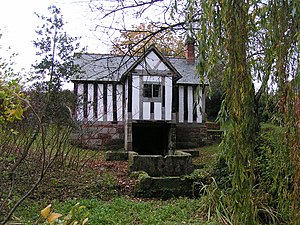| Saint Winifred | |
|---|---|
| St Winifred's Well, Woolston, Shropshire | |
| Virgin, Martyr & Abbess | |
| Born | Flintshire |
| Died | c. 660, Gwytherin in Denbighshire |
| Venerated in | Orthodox Church; Roman Catholic Church; Anglican Communion |
| Major shrine | Shrewsbury Abbey, now destroyed although a small part of the shrine base survives. Holywell, fully active Catholic holy well and well-house shrine. |
| Feast | 3 November |
| Attributes | abbess holding a sword, sometimes with her head under her arm |
| Patronage | Holywell; Shrewsbury; against unwanted advances |
Saint Winefride (called in her native Welsh: Gwenffrewi; in modern English Winifred and various variations) was a legendary 7th century Welsh noblewoman who was canonized after dying for the sake of her chastity. A healing spring at the site of her death is now a shrine and pilgrimage site called St Winefride's Well in Holywell, known as the Lourdes of Wales. In modern times, St Winefride has been unofficially adopted as the patron saint of payrolls and payroll clerks.
According to legend, Winefride was the daughter of a Welsh nobleman, Tyfid ap Eiludd. Her suitor, Caradog, was enraged when she decided to become a nun, and decapitated her. In one version of the tale, her head rolled downhill, and, where it stopped, a healing spring appeared. Winefride's head was subsequently rejoined to her body due to the efforts of her maternal uncle, Saint Beuno, and she was restored to life. She later became a nun and abbess at Gwytherin in Denbighshire, and Caradog, cursed by Beuno, melted into the ground.[1] More elaborate versions of this tale relate many details of her life, including Winefride's pilgrimage to Rome.
In spite of the slim records for this period, there appears to be a historical basis for this personage. Winefride's brother Owain is known to have killed Caradog as revenge for a crime. She succeeded the Abbess, Saint Tenoi, who is believed to be her maternal grand-aunt.[2]
Veneration[]
After her death (c. 660) Winefride was interred at her abbey. In 1138, relics were carried to Shrewsbury to form the basis of an elaborate shrine.[1] The shrine and well became major pilgrimage goals in the Late Middle Ages, but the shrine was destroyed by Henry VIII in 1540.
Another well named after St Winifred is in the hamlet of Woolston near Oswestry in Shropshire. It is thought that on her way to Shrewsbury Abbey, Winifred's body was laid here overnight and a spring sprang up out of the ground. The water is supposed to have healing powers and be good at healing bruises, wounds and broken bones. The well is covered by a 15th-century half-timbered cottage. The water flows through a series of stone troughs and into a large pond, which then flows into a stream. The cottage is in a quiet, peaceful setting in the middle of the countryside, and is maintained by the Landmark Trust.
Another spring supposedly arising from the laying down of Winefride's body is at Holywell Farm, midway between Tattenhall and Clutton, Cheshire. There is a spring in the garden of this non-working farm which supplies two houses with their drinking water.
A Norman church dedicated to Saint Winifrede can be found in the village of Branscombe, Devon. There is some archaeological evidence to suggest an earlier Saxon church may have occupied the site.
References in literature[]
William Rowley's seventeenth century comedy A Shoemaker a Gentleman dramatizes Saint Winefride's story, based on the version in Thomas Deloney's story The Gentle Craft (1584).
English poet Gerard Manley Hopkins memorialized Saint Winefride in his unfinished drama, St Winefred's Well.
The moving of Winefride's bones to Shrewsbury is fictionalized in A Morbid Taste for Bones, the first of Ellis Peters' Brother Cadfael novels. Saint Winefride (or as they call her, Winifred) is an important "character" in all the books in the Brother Cadfael series. The celebration of her Feast Day provides the setting for two of the novels, The Rose Rent and The Pilgrim of Hate. Her casket is actually stolen from its shrine in The Holy Thief, and the campaign to find and restore it propels the action. Throughout the series, the protagonist, Brother Cadfael - a Welsh monk at the English monastery at Shrewsbury - has a kind of "special understanding" with the saint, whom he affectionately calls "The Girl".
St. Winefride's Well is mentioned in the medieval poem Sir Gawain and the Green Knight.
Notes[]
- ↑ 1.0 1.1 Cormack, Margaret (2007). Saints and their cults in the Atlantic world. Columbia, S.C: University of South Carolina Press. pp. 204–206. ISBN 1-57003-630-6. http://books.google.com/books?id=Ker_beVinJ8C&pg=PA204&vq=Saint+Winefride&dq=%22Saint+Winefride%22&lr=&as_brr=3&source=gbs_search_s&sig=ACfU3U1b1rw19W_eg_XMfalAZ-Jev5y8jA.
- ↑ Brad Olsen (2007). Sacred Places Europe: 108 Destinations (Sacred Places: 108 Destinations series). CCC Publishing. pp. 58. ISBN 1-888729-12-0. http://books.google.com/books?id=cdM3qHlNeb4C&pg=PA58&dq=%22Saint+Winefride%22&lr=&as_brr=3&ei=WY-YSKzkG5egiwGTv4nRBw&sig=ACfU3U1oFJVbxkCWcAJ8XZwSDaP5Oq5G7A.
External links[]
- Rees, Rice (1836), "Legend of Gwenfrewi or St. Winefred", An Essay on the Welsh Saints, London: Longman, Rees, Orme, Brown, Green, and Longman, Rees, pp. 295–297, http://books.google.com/books?id=H8IclDShLSYC&pg=PA295
- Rees, William Jenkins, ed. (1853), "Life of St. Winefred", Lives of the Cambro-British Saints, Llandovery: William Rees, pp. 515–529, http://books.google.com/books?id=uOsOAAAAIAAJ&pg=PA515
br:Gwenfrewi cy:Gwenffrewi
